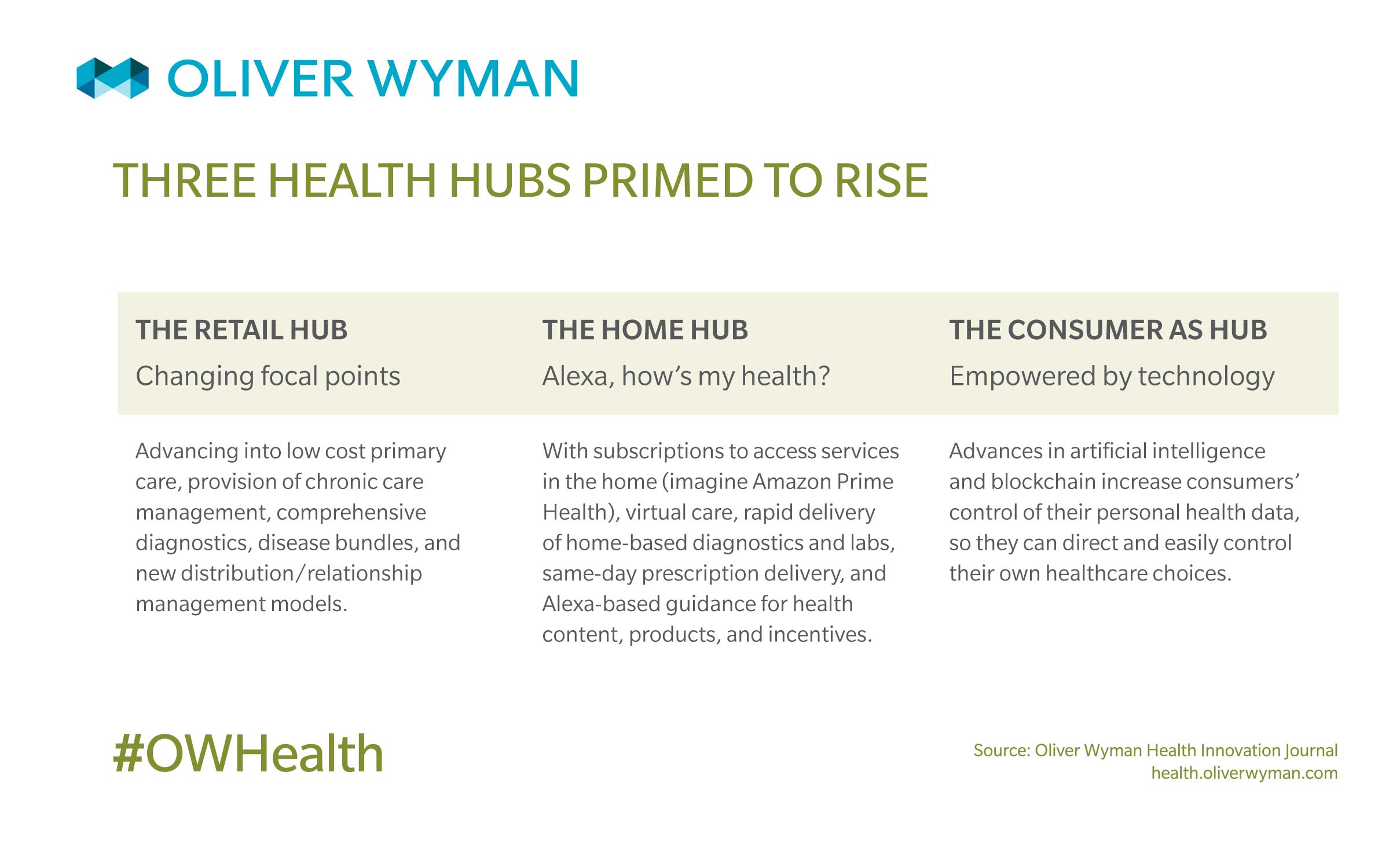Editor's Note: This piece was originally published in the 2018 Oliver Wyman Health Innovation Journal.
Accessing the healthcare system has traditionally meant either heading to a doctor’s office or straight to the emergency room, with little in between. Until now, that is. The corner retail store, our phones, and our homes are now gateways to more convenient, affordable care. Consumers using these care alternatives really like them. According to Oliver Wyman’s 2018 Consumer Survey, over a third of consumers – 35 percent – who used a retail clinic in the past year preferred this experience over a traditional doctor’s office visit. Yet, traditional primary care is still far and away healthcare’s prevailing front door, as consumer awareness of these new options and capabilities is inconsistent at best. From a benefit design perspective, insurance products still revolve around traditional provider networks, and reimbursement and legislation to catalyze adoption are lagging in areas like virtual medicine. What emerges from this picture? We see an industry where care alternatives have proliferated, but healthcare’s front door has not (yet) been fundamentally altered, and where solutions do not connect the dots for consumers in compelling ways.
WHAT’S NEXT? PREPARE FOR A REINVENTED FRONT DOOR
Over the next decade, will innovation keep nibbling at the edges of the market, or will there be significant demand shifts? How can industry leaders navigate such uncertainty? Other regulated industries – including banking, retail, and transportation – have experienced dramatic changes driven by consumers and technology. Yet healthcare remains a stubborn outlier, despite unaffordable costs and widespread consumer frustration. The good news is major vertical integration gambits from the past 12 months offer glimpses into bigger shifts on the horizon. We predict these shifts will occur across four dimensions.
THE FIRST DIMENSION: CLOSED LOOP ECOSYSTEMS
While more front end care options exist, the consumer experience remains disjointed. For example, an urgent care facility often operates in isolation from a primary care physician. The first, more modest evolution likely to emerge is front end choice integration – a multi-modal constellation of physical and digital care that lets consumers seamlessly shift between settings. The second larger shift is the advent of “closed loop” ecosystems that collapse traditional value chain boundaries – including members, patients, consumers, payers, providers, and retailers. Organizations like Kaiser and Geisinger have operated integrated models for decades. Now we will see new companies vying to catch and create exclusive, preferred front end networks with much higher service levels – integrating triage, diagnostics, pharmacy, payment, and even handoffs, to preferred downstream care partners (such as specialists and acute care providers) without ever “dropping the consumer.” This makes the CVS-Aetna merger prospect fascinating, given its more than 10,000 access points and an Aetna membership chassis.
We see an industry where care alternatives have proliferated, but healthcare’s front door has not (yet) been fundamentally altered, and where solutions do not connect the dots for consumers in compelling ways.
Closed loop models are beginning to emerge in chronic care where companies such as Onduo and Livongo are creating ecosystems for diabetes management. The "front end" is constituted in these organizations' constant health-status monitoring, algorithm-driven alerts, health coaching, real-time dosing adjustments, and in the case of Onduo, endocrinologists to direct care. New ecosystems are primed to form around consumer segments (such as demographic, psychographic, and health status) that operate differently than “single chain” players.
THE SECOND DIMENSION: NEW HEALTH HUBS
With extraordinary pressure on provider economics and reimbursement, there’s greater emphasis on lower cost settings such as ambulatory surgery centers, retail-based imaging, and comprehensive ambulatory centers. One-stop-shop ambulatory offerings appear poised for significant growth. But this presumes the provision of care’s front door is on provider terms and that they move fast enough, given the mixed incentives of hospital-based billing as a major profit engine. In the background, three other health hubs are primed to rise:
Societally, we have spent decades reinforcing healthcare’s core vision, with absolute trust in physicians, services delivered on the system’s terms, and acceptance of limited, inflexible models, and opaque systems. Yet new models are changing these rules and placing choice and control into patients’ hands.
THE THIRD DIMENSION: THE FRONT DOOR MOVES UPSTREAM
Consumers are still navigating the confounding, expensive maze of healthcare largely alone. The industry remains geared around response care. Helping consumers become educated advocates along their care journey is the raison d’etre of emerging players. Companies like Zocdoc and Walgreens (through Find Care Now) are guiding individuals to available supply. WebMD – with 199 million active users and its recent acquisitions of Vitals.com and MediQuality.com – is primed to become more of a system conductor. Consumers barely bat an eye before hopping online to WebMD to type in a list of symptoms as opposed to first calling their primary care physicians (or an ambulance, for that matter). Others, such as Accolade and Welltok, are innovating with proprietary engagement, navigation, and health optimization platforms to connect with individuals as people, not just patients.
Companies like these understand the potential to reshape consumer health relationships. Not just when someone experiences an “episode,” but on a durable, continuous, and proactive basis. But we have yet to see platform players that can:
- Create a shopping marketplace for healthcare services, breaking the traditional local network model.
- Reverse the waterways of the healthcare relationship/interaction model and become a trusted adviser on the consumer’s side for a gamut of needs (imagine a healthcare and wellness concierge that helps consumers make informed decisions).
- Integrate deep understanding of consumer habits, motivation, and history to “activate” consumers to live healthy lives. There’s a market void for players to jump in and function as a “GPS for health.”
THE FOURTH DIMENSION: LET’S NOT FORGET ABOUT DRUGS
The framework that underpins US healthcare access is oriented around managing medical expenses. The largest area of spend growth, however, currently resides on the pharmacy side. Here, US drug spend is highly concentrated – 0.3 percent of people drive over 20 percent of pharmacy spend in areas like immunology, oncology, and hemotology. The nature and complexity of related diseases requires a different approach than what has proven to be successful in managing lifestyle conditions like diabetes and heart failure. Who will be tomorrow’s emerging leaders in managing the pharmacy value chain and associated drug costs? The answers are unclear. However, bets are being made. The CVS-Aetna merger prospect joins a strong, consumer-smart pharmacy business with a focus on fostering intimate connections. Other bets involve a payer-enabled actuarial view with pharmacy benefit manager assets supporting their moves, such as the Cigna and Express Scripts merger. Precision medicine companies such as Envision Genomics aim to create care models for specialized populations and rare diseases costing the system billions in drug spend. Even health systems are participating. Intermountain Healthcare is launching a not-for-profit generic drug company with Ascension, SSM Health, and Trinity Health to reduce unjustified shortages and high prices for life-saving generic medications. Soon, those managing the steepening “drug spend pyramid” will have a distinct advantage.
In the next decade, incumbents and innovators vying for a different relationship with consumers will shape healthcare’s front end.
IN WHICH LANES WILL YOU COMPETE?
Where should your organization be focused next as the front end of healthcare hurtles through this period of change? Convenience? Experience? Price? Journey integration? Consumer understanding and intimacy? Or should you aim for all of the aforementioned, and more? Whatever your answer, here are several key considerations:
- Access will become table stakes. Differentiation will come from a highly choreographed care journey that fosters consumer intimacy.
- The race for consumer data is on. While electronic medical records generate volumes of clinical data, this data needs to be enriched with consumer intelligence to drive innovation onward.
- Ecosystems will emerge, and it’s unlikely any single player can amass the capabilities necessary to meet consumer expectations. Execution will require a constellation of solutions, where flawless operational integration will make (or break) their success.
Whatever lanes you compete in, delivering reliably on tailored value propositions tied to the desires and needs of your target population will propel you. In the next decade, incumbents and innovators vying for a different relationship with consumers will shape healthcare’s front end. Place your bets now on whether this means modest change is on the way – or whether we face a seismic redefinition of healthcare as we know it.




